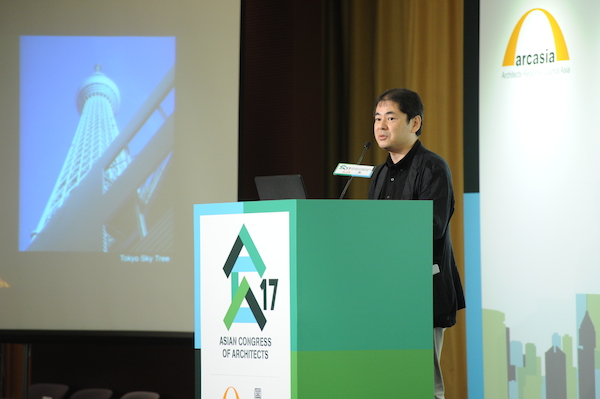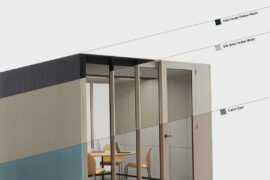At ACA17, the Nikken Sekkei architect spoke about digital technologies, and how they will change the way architects work.

October 13th, 2016
Pictured above is the Hoki Museum. Yamanashi used BIM to control the building’s complex, curving forms
How we make things is changing. So says Tomohiko Yamanashi, Senior Executive Officer and Deputy Head of the Architectural Design Department at Nikken Sekkei, the Japanese urban planning, design, architecture and project management consulting giant.
Yamanashi spoke about this topic, and specifically, about how digital technologies are affecting the way we make things, at ACA17, the 17th Asian Congress of Architects, in Hong Kong on 29 September 2016. He was one of the keynote speakers at the event, and he advocated the balanced use of Information and Communication Technology (ICT) – such as computer simulations, computation design and digital fabrication – the Internet of Things and Artificial Intelligence (AI), among other technologies, in order to achieve mass customisation and to plan better in order to achieve better, more sustainable buildings.
Yamanashi has used these technologies on projects such as the headquarters for the Lumber Wholesaler Association (Mozukai Kaikan), Hoki Museum (which is dedicated to Realism), Sony City Osaki (Sony’s R&D headquarters), and many others. Here, he talks about the value of ICT in 21st-century architecture.

Yamanashi was one of the keynote speakers at ACA17
What led you to appreciate digital technologies?
I started working with BIM [Building Information Modeling, a 3D modeling software], and gradually I saw the value of computer simulations. So five years ago, I built a special digital team called DDL – Digital Design Laboratory. Now I use ICT in all my projects, to realise my designs.
Why is ICT important?
If we use ICT effectively, computer simulations can help us can reduce costs, and we can reduce material wastage. We can also use it to reduce the amount of energy a building uses.
It’s very difficult to predict what will happen after completion if you’re only using 2D design, and it’s very important to be able to check the quality of your design. If we can use things like Virtual Reality (VR) throughout the process, before completion, we can predict what will happen after completion.
Architecture is really about communication, too. It’s very important to establish good communications before completion, with your client and the contractor. And this is where VR comes in: it will help them understand what you’re trying to build from the beginning.
If you present clients with 2D drawings, they tend to say, ‘Yes, I like it,’ but they don’t always understand what they’re saying yes to. By being able to walk through a simulation of a building before it’s built, they will have a much better understanding of your scheme.
And from an architect’s point of view, we architects are very lazy; we want to expend our energy creating something. I don’t want to spend my time dealing with process. if AI and other ICT technologies can help architects with the basics, then we can concentrate on the creative aspects of a project. For example, if you write some text, you may want to concentrate on the creative side of writing, but you may not want to spend time checking the text after it’s written. It’s less creative. If we could use AI for this, it would change the way we work – drastically. It’s a dream of mine!
Some designers talk about the importance of the handmade. What’s your view on this?
Some complete geeks try to use only computers, but architecture is for human beings. If we can use technologies smartly, we can execute a real balance between the two. The most important thing to me is how to find a good balance between ICT and humans.
My work looks very human, I think. My shapes are very ordinary. Activity and wind flow inside is very important to me.
You talk about mass customisation as the replacement for mass production in the 21st century. Please could you tell us more?
In the 20th century, architects tried to hold onto this ideal of mass production. But architecture was originally about producing things one-by-one – it should be unique.
In the 20th century, we didn’t have any good solutions for confirming whether our ideas worked or not, and mass production helped with this. Now we have so many ways of testing whether our ideas work or not – and long before completion.
Nikken Sekkei Ltd.
nikken.co.jp
ACA17
aca17hk.com
INDESIGN is on instagram
Follow @indesignlive
A searchable and comprehensive guide for specifying leading products and their suppliers
Keep up to date with the latest and greatest from our industry BFF's!

London-based design duo Raw Edges have joined forces with Established & Sons and Tongue & Groove to introduce Wall to Wall – a hand-stained, “living collection” that transforms parquet flooring into a canvas of colour, pattern, and possibility.
The new range features slabs with warm, earthy palettes that lend a sense of organic luxury to every space.
The internet never sleeps! Here's the stuff you might have missed

A new online space offers designers enhanced tools, resources and real-time customisation.

The undeniable thread connecting Herman Miller and Knoll’s design legacies across the decades now finds its profound physical embodiment at MillerKnoll’s new Design Yard Archives.